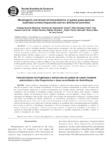Please use this identifier to cite or link to this item:
http://www.alice.cnptia.embrapa.br/alice/handle/doc/901685| Title: | Morphogenetic and structural characteristics of guinea grass pastures submitted to three frequencies and two defoliation severities. |
| Authors: | BARBOSA, R. A.  NASCIMENTO JÚNIOR, D. do   VILELA, H. H   SILVA, S. C. da   EUCLIDES, V. P. B.   SBRISSIA, A. F.   SOUSA, B. M. de L.   |
| Affiliation: | RODRIGO AMORIM BARBOSA, CNPGC; Domicio do Nascimento Júnior, Universidade Federal de Viçosa, Departamento de Zootecnia, Viçosa/MG.; Hélio Henrique Vilela, Universidade Federal de Viçosa, Departamento de Zootecnia, Viçosa/MG.; Sila Carneiro da Silva, Universidade de São Paulo, Escola Superior de Agricultura “Luiz de Queiroz”, Departamento de Zootecnia, Piracicaba/SP.; VALERIA PACHECO BATISTA EUCLIDES, CNPGC; André Fischer Sbrissia, Universidade do Estado de Santa Catarina, Departamento de Produção Animal e Alimentos, Lages/SC; Braulio Maia de Lana Sousa, Universidade Federal de Viçosa, Departamento de Zootecnia, Viçosa/MG. |
| Date Issued: | 2011 |
| Citation: | Revista Brasileira de Zootecnia,v.40, n.5, p.947-954, 2011. |
| Description: | It was evaluated the morphogenic and structural characteristics of guinea grass under rotational at three grazing intervals and two defoliation intensities. Grazing intervals corresponded to the time needed by the forage canopy to reach 90, 95 or 100% of incident light interception during regrowth and they were evaluated combined to two defoliation severities (post-grazing conditions, 25 and 50 cm of height), being allocated to experimental units according to a complete randomized design, with three replicates and 3 × 2 factorial arrangement. The experiment was conducted from July 2003 to May 2004. For evaluation of morphogenetic and structural characteristics, ten tillers per experimental unit were selected. Morphogenetic and structural characteristics were strongly influenced by seasons of the year inasmuch as leaf elongation rate increased 3.5 fold from winter to summer. In addition to year season effect, there was also an effect of defoliation frequencies on tiller population density, which was greater in the defoliation period corresponding to 90% of light interception, especially if evaluated in relation to the interval corresponding to 100% of light interception. Defoliation frequency is determinant in expression of phenotypic plasticit, acting on the control of stem elongation. |
| Thesagro: | Pastagem Panicum Maximum |
| Keywords: | Manejo do pastejo |
| Type of Material: | Artigo de periódico |
| Access: | openAccess |
| Appears in Collections: | Artigo em periódico indexado (CNPGC)  |
Files in This Item:
| File | Description | Size | Format | |
|---|---|---|---|---|
| valeria2.pdf | 71.29 kB | Adobe PDF |  View/Open |









